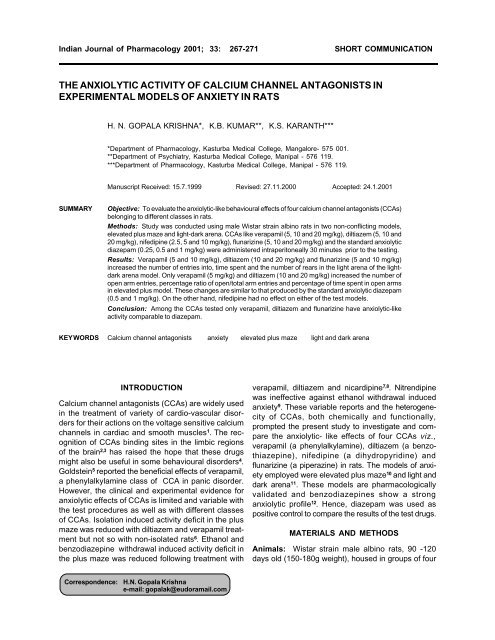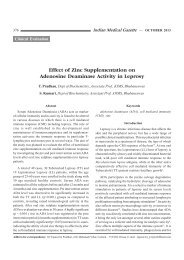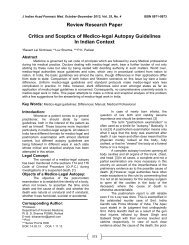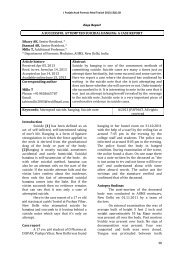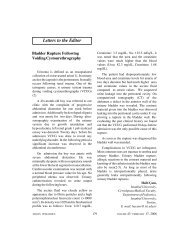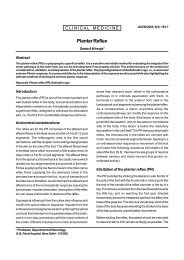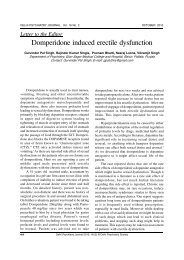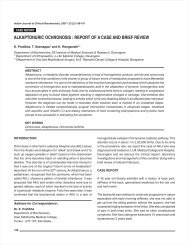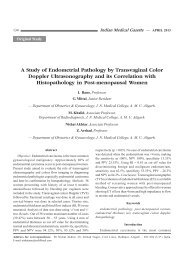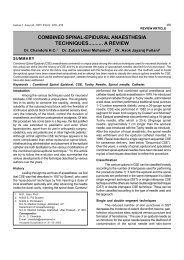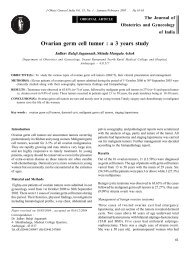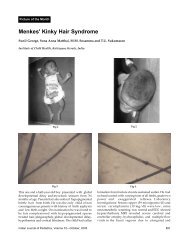The anxiolytic activity of calcium channel antagonists in ... - medIND
The anxiolytic activity of calcium channel antagonists in ... - medIND
The anxiolytic activity of calcium channel antagonists in ... - medIND
Create successful ePaper yourself
Turn your PDF publications into a flip-book with our unique Google optimized e-Paper software.
Indian Journal <strong>of</strong> Pharmacology 2001; 33: 267-271 SHORT COMMUNICATION<br />
ANXIOLYTIC ACTIVITY OF CALCIUM CHANNEL ANTAGONISTS<br />
THE ANXIOLYTIC ACTIVITY OF CALCIUM CHANNEL ANTAGONISTS IN<br />
EXPERIMENTAL MODELS OF ANXIETY IN RATS<br />
H. N. GOPALA KRISHNA*, K.B. KUMAR**, K.S. KARANTH***<br />
*Department <strong>of</strong> Pharmacology, Kasturba Medical College, Mangalore- 575 001.<br />
**Department <strong>of</strong> Psychiatry, Kasturba Medical College, Manipal - 576 119.<br />
***Department <strong>of</strong> Pharmacology, Kasturba Medical College, Manipal - 576 119.<br />
Manuscript Received: 15.7.1999 Revised: 27.11.2000 Accepted: 24.1.2001<br />
SUMMARY<br />
Objective: To evaluate the <strong>anxiolytic</strong>-like behavioural effects <strong>of</strong> four <strong>calcium</strong> <strong>channel</strong> <strong>antagonists</strong> (CCAs)<br />
belong<strong>in</strong>g to different classes <strong>in</strong> rats.<br />
Methods: Study was conducted us<strong>in</strong>g male Wistar stra<strong>in</strong> alb<strong>in</strong>o rats <strong>in</strong> two non-conflict<strong>in</strong>g models,<br />
elevated plus maze and light-dark arena. CCAs like verapamil (5, 10 and 20 mg/kg), diltiazem (5, 10 and<br />
20 mg/kg), nifedip<strong>in</strong>e (2.5, 5 and 10 mg/kg), flunariz<strong>in</strong>e (5, 10 and 20 mg/kg) and the standard <strong>anxiolytic</strong><br />
diazepam (0.25, 0.5 and 1 mg/kg) were adm<strong>in</strong>istered <strong>in</strong>traperitoneally 30 m<strong>in</strong>utes prior to the test<strong>in</strong>g.<br />
Results: Verapamil (5 and 10 mg/kg), diltiazem (10 and 20 mg/kg) and flunariz<strong>in</strong>e (5 and 10 mg/kg)<br />
<strong>in</strong>creased the number <strong>of</strong> entries <strong>in</strong>to, time spent and the number <strong>of</strong> rears <strong>in</strong> the light arena <strong>of</strong> the lightdark<br />
arena model. Only verapamil (5 mg/kg) and diltiazem (10 and 20 mg/kg) <strong>in</strong>creased the number <strong>of</strong><br />
open arm entries, percentage ratio <strong>of</strong> open/total arm entries and percentage <strong>of</strong> time spent <strong>in</strong> open arms<br />
<strong>in</strong> elevated plus model. <strong>The</strong>se changes are similar to that produced by the standard <strong>anxiolytic</strong> diazepam<br />
(0.5 and 1 mg/kg). On the other hand, nifedip<strong>in</strong>e had no effect on either <strong>of</strong> the test models.<br />
Conclusion: Among the CCAs tested only verapamil, diltiazem and flunariz<strong>in</strong>e have <strong>anxiolytic</strong>-like<br />
<strong>activity</strong> comparable to diazepam.<br />
KEY WORDS<br />
Calcium <strong>channel</strong> <strong>antagonists</strong> anxiety elevated plus maze light and dark arena<br />
INTRODUCTION<br />
Calcium <strong>channel</strong> <strong>antagonists</strong> (CCAs) are widely used<br />
<strong>in</strong> the treatment <strong>of</strong> variety <strong>of</strong> cardio-vascular disorders<br />
for their actions on the voltage sensitive <strong>calcium</strong><br />
<strong>channel</strong>s <strong>in</strong> cardiac and smooth muscles 1 . <strong>The</strong> recognition<br />
<strong>of</strong> CCAs b<strong>in</strong>d<strong>in</strong>g sites <strong>in</strong> the limbic regions<br />
<strong>of</strong> the bra<strong>in</strong> 2,3 has raised the hope that these drugs<br />
might also be useful <strong>in</strong> some behavioural disorders 4 .<br />
Goldste<strong>in</strong> 5 reported the beneficial effects <strong>of</strong> verapamil,<br />
a phenylalkylam<strong>in</strong>e class <strong>of</strong> CCA <strong>in</strong> panic disorder.<br />
However, the cl<strong>in</strong>ical and experimental evidence for<br />
<strong>anxiolytic</strong> effects <strong>of</strong> CCAs is limited and variable with<br />
the test procedures as well as with different classes<br />
<strong>of</strong> CCAs. Isolation <strong>in</strong>duced <strong>activity</strong> deficit <strong>in</strong> the plus<br />
maze was reduced with diltiazem and verapamil treatment<br />
but not so with non-isolated rats 6 . Ethanol and<br />
benzodiazep<strong>in</strong>e withdrawal <strong>in</strong>duced <strong>activity</strong> deficit <strong>in</strong><br />
the plus maze was reduced follow<strong>in</strong>g treatment with<br />
verapamil, diltiazem and nicardip<strong>in</strong>e 7,8 . Nitrendip<strong>in</strong>e<br />
was <strong>in</strong>effective aga<strong>in</strong>st ethanol withdrawal <strong>in</strong>duced<br />
anxiety 9 . <strong>The</strong>se variable reports and the heterogenecity<br />
<strong>of</strong> CCAs, both chemically and functionally,<br />
prompted the present study to <strong>in</strong>vestigate and compare<br />
the <strong>anxiolytic</strong>- like effects <strong>of</strong> four CCAs viz.,<br />
verapamil (a phenylalkylam<strong>in</strong>e), diltiazem (a benzothiazep<strong>in</strong>e),<br />
nifedip<strong>in</strong>e (a dihydropyrid<strong>in</strong>e) and<br />
flunariz<strong>in</strong>e (a piperaz<strong>in</strong>e) <strong>in</strong> rats. <strong>The</strong> models <strong>of</strong> anxiety<br />
employed were elevated plus maze 10 and light and<br />
dark arena 11 . <strong>The</strong>se models are pharmacologically<br />
validated and benzodiazep<strong>in</strong>es show a strong<br />
<strong>anxiolytic</strong> pr<strong>of</strong>ile 12 . Hence, diazepam was used as<br />
positive control to compare the results <strong>of</strong> the test drugs.<br />
MATERIALS AND METHODS<br />
Animals: Wistar stra<strong>in</strong> male alb<strong>in</strong>o rats, 90 -120<br />
days old (150-180g weight), housed <strong>in</strong> groups <strong>of</strong> four<br />
Correspondence: H.N. Gopala Krishna<br />
e-mail: gopalak@eudoramail.com
268<br />
H.N. GOPALA KRISHNA et al.<br />
Table 1.<br />
Effects <strong>of</strong> diazepam and <strong>calcium</strong> <strong>channel</strong> <strong>antagonists</strong> on behaviour <strong>of</strong> rats <strong>in</strong> elevated plus maze paradigm.<br />
Treatments Kg -1 Number Number <strong>of</strong> entries Percentage ratio <strong>of</strong> Percentage <strong>of</strong><br />
open / total arm time spent <strong>in</strong><br />
Open arm Total arm entries open arms<br />
Tween - 20 1 ml 12 0.75 + 0.25 3.42 + 0.48 17.50 + 5.61 2.55 + 1.09<br />
Diazepam 0.25 mg 8 1.50 + 0.25 4.50 + 1.01 27.42 + 6.56 4.00 + 1.40<br />
0.50 mg. 8 2.87 + 0.51* 7. 50 + 1.18* 37.95 + 2.15* 13.08 + 3.10*<br />
1.00 mg 8 2.62 + 0.67* 5.87 + 1.17 43.54 + 4.54* 8.04 + 1.28*<br />
Nifedip<strong>in</strong>e 2.50 mg 8 1.12 + 0.54 5.37 + 1.10 13.51 + 5.77 3.70 + 1.72<br />
5.00 mg 8 0.87 + 0.44 3.25 + 0.90 17.18 + 9.06 2.20 + 1.09<br />
10.00 mg 8 0.87 + 0.39 4.37 + 0.32 17.50 + 7.19 3.87 + 1.75<br />
Flunariz<strong>in</strong>e 5.00 mg 8 1.13 + 0.39 4.00 + 0.75 24.47 + 8.34 4.00 + 1.07<br />
10.00 mg 8 1.87 + 0.44 5.13 + 0.58 37.43 + 7.75 7.08 + 2.27<br />
20.00 mg 8 1.13 + 0.04 4. 37 + 0.53 20.94 + 7.07 4.87 + 1.88<br />
Sal<strong>in</strong>e 1.00 ml 12 0.83 + 0.24 3.92 + 0.50 20.55 + 5.87 1.91 + 0.80<br />
Diltiazem 5.00 mg 8 1.25 + 0.31 4.50 + 0.88 30.42 + 7.74 4.74 + 1.35<br />
10.00 mg 8 2.25 + 0.55* 6.25 + 1.30 31.21 + 7.36 10.29 + 2.70*<br />
20.00 mg 8 2.00 + 0.46* 4.37 + 0.59 46.63 + 7.10* 6.53 + 2.05<br />
Verapamil 5.00 mg 8 3.25 + 0.67* 7.25 + 1.22* 46.11 + 4.60* 14.91 + 2.99*<br />
10.00 mg 8 1.50 + 0.46 3.87 + 0.99 35.00 + 7.79 5.45 + 1.83<br />
20.00 mg 8 0.50 + 0.37 2.50 + 0.37 10.00 + 7.55 1.91 + 1.60<br />
Values are mean + SEM<br />
* P< 0. 05 significantly different from their respective vehicle treated control group. (ANOVA followed by Dunnett's ‘ t ’ test)<br />
<strong>in</strong> a climate controlled room with twelve hours light<br />
and twelve hours dark cycle (lights on 7.00 to19.00<br />
hours) were used. <strong>The</strong>y had free access to food and<br />
water. Experiments were conducted between 9. 00<br />
to 14. 00 hours.<br />
Drugs: Verapamil and diltiazem were dissolved <strong>in</strong><br />
normal sal<strong>in</strong>e. Nifedip<strong>in</strong>e, flunariz<strong>in</strong>e and diazepam<br />
were dissolved or suspended <strong>in</strong> 1% aqueous<br />
Tween-20. Freshly prepared drugs solutions were<br />
<strong>in</strong>jected <strong>in</strong>traperitonially, 30 m<strong>in</strong>utes prior to the test<strong>in</strong>g,<br />
<strong>in</strong> the volume <strong>of</strong> 0.1 ml/100 g body weight.<br />
<strong>The</strong> doses <strong>of</strong> each drug were selected on the basis<br />
<strong>of</strong> prelim<strong>in</strong>ary screen<strong>in</strong>g effects on muscle tone, gait<br />
and excitation or sedation. Three doses <strong>of</strong> each drug<br />
that have not affected the above parameters were<br />
used. Concurrent control groups <strong>of</strong> animals received<br />
appropriate volume <strong>of</strong> either <strong>of</strong> the placebo solvents<br />
(sal<strong>in</strong>e or 1% aqueous Tween-20). Drugs, dosage<br />
and number <strong>of</strong> animals used per treatment are<br />
shown <strong>in</strong> Tables 1 & 2.<br />
Apparatus: <strong>The</strong> elevated plus maze 10 consisted <strong>of</strong><br />
two open arms (50 x 10 cm) and two enclosed arms<br />
<strong>of</strong> the same size with 40 cm high wall arranged so<br />
that the arms <strong>of</strong> the same type were opposite to each<br />
other, with a central square <strong>of</strong> 10 cm. <strong>The</strong> apparatus<br />
was wooden and was elevated to a height <strong>of</strong> 50 cm<br />
above the floor. <strong>The</strong> light and dark arena 11 consisted<br />
<strong>of</strong> an open top wooden box with two dist<strong>in</strong>ct chambers.<br />
<strong>The</strong> small chamber (20 x 30 x 35 cm) was<br />
pa<strong>in</strong>ted black and illum<strong>in</strong>ated with dimmed red light.<br />
<strong>The</strong> big chamber (30 x 30 x 35 cm) pa<strong>in</strong>ted white<br />
and brightly illum<strong>in</strong>ated with 100 W white light located
ANXIOLYTIC ACTIVITY OF CALCIUM CHANNEL ANTAGONISTS<br />
269<br />
Table 2.<br />
Effects <strong>of</strong> diazepam and <strong>calcium</strong> <strong>channel</strong> <strong>antagonists</strong> on behaviours <strong>of</strong> rats <strong>in</strong> light and dark arena paradigm.<br />
Treatments Kg -1 Number Number <strong>of</strong> entries Percentage <strong>of</strong> time Number <strong>of</strong> rears<br />
<strong>in</strong>to the light arena spent <strong>in</strong> light arena <strong>in</strong> light arena<br />
Tween- 20 1 ml 12 1.41 + 0.19 3.87 + 0.80 1.08 + 0. 28<br />
Diazepam 0.25 mg 8 1.87 + 0.33 6.70 + 1.53 3.12 + 0.97<br />
0.50 mg 8 3.12 + 0.61* 13.99 + 3.38* 4.50 + 1.22*<br />
1.00 mg 8 2.37 + 0.32 13.79 + 2.15* 4.62 + 0.57*<br />
Nifedip<strong>in</strong>e 2.50 mg 8 1.50 + 0.19 4.50 + 1.19 1.12 + 0.47<br />
5.00 mg 8 1.75 + 0.31 8.20 + 1.39 2.37 + 0.62<br />
10.00 mg 8 1.75 + 0.36 8.37 + 2.21 1.87 + 1.21<br />
Flunariz<strong>in</strong>e 5.00 mg 8 2.87 + 0.51* 13.54 + 2.19* 5.62 + 1.80*<br />
10.00 mg 8 3.50 + 0.26* 15.82 + 2.45* 8.12 + 1.17*<br />
20.00 mg 8 2.37 + 0.49 9.45 + 2.11 4.50 + 1.19*<br />
Sal<strong>in</strong>e 1 ml 12 1.50 + 0.19 4.93 + 0.87 1.33 + 0.25<br />
Diltiazem 5.00 mg 8 2.37 + 0.37 10.95 + 3.24 3.12 + 0.97<br />
10.00 mg 8 3.00 + 0.56* 14.33 + 2.74* 3.87 + 1.12*<br />
20.00 mg 8 3.00 + 0.46* 17.83 + 3.11* 4.12 + 0.87*<br />
verapamil 5.00 mg 8 2.12 + 0.46 11.45 + 2.24* 3.75 + 1.01*<br />
10.00 mg 8 2.50 + 0.53* 15.37 + 4.73* 3.00 + 0.59*<br />
20.00 mg 8 1.00 + 0.00 4.54 + 1.17 0.37 + 0.26<br />
Values are mean + SEM.<br />
* P< 0.05 significantly different from their respective vehicle treated control group. (ANOVA followed by Dunnett's ‘ t ’ test)<br />
17 cm above the box. <strong>The</strong>se chambers were connected<br />
by a small open door (7.5 x 5 cm) located at<br />
the floor level <strong>in</strong> the center <strong>of</strong> the partition.<br />
Behavioural assessment procedure: Validation <strong>of</strong><br />
conduct<strong>in</strong>g the experiments employ<strong>in</strong>g both the models<br />
<strong>in</strong> a s<strong>in</strong>gle sett<strong>in</strong>g was carried out as described<br />
earlier from our laboratory 13 . Control studies didn’t<br />
reveal any significant difference between s<strong>in</strong>gle sett<strong>in</strong>g<br />
and different day trial procedures. Hence, each<br />
animal was tested <strong>in</strong>itially <strong>in</strong> plus maze and then <strong>in</strong><br />
light-dark arena paradigm <strong>in</strong> a s<strong>in</strong>gle sett<strong>in</strong>g. Thirty<br />
m<strong>in</strong>utes after the treatment, each rat was placed <strong>in</strong><br />
the center square <strong>of</strong> the plus maze, fac<strong>in</strong>g one <strong>of</strong> the<br />
enclosed arms and the number <strong>of</strong> entries <strong>in</strong>to and<br />
the time spent <strong>in</strong> open and enclosed arms and the<br />
total number <strong>of</strong> arm entries for a period <strong>of</strong> 5 m<strong>in</strong>utes<br />
were monitored. Follow<strong>in</strong>g this test, each rat was<br />
placed <strong>in</strong> the center <strong>of</strong> the light arena <strong>of</strong> light-dark<br />
arena apparatus. <strong>The</strong> number <strong>of</strong> entries <strong>in</strong>to the light<br />
arena, time spent and the number <strong>of</strong> rear<strong>in</strong>g <strong>in</strong> the<br />
light arena were recorded for 5 m<strong>in</strong>utes. <strong>The</strong> apparatus<br />
was cleaned after each trial.<br />
Statistics: Data were analyzed us<strong>in</strong>g analysis <strong>of</strong> variance<br />
(ANOVA) with drug treatment as the <strong>in</strong>dependent<br />
factor. Wherever a significant difference (5% level)<br />
was noted post-hoc comparisons between drugged<br />
animals and control were made us<strong>in</strong>g Dunnett’s ' t '<br />
test.<br />
RESULTS<br />
Elevated Plus Maze (Table - 1)<br />
Diazepam (0.5 and 1 mg/kg) treated rats showed an<br />
<strong>in</strong>crease <strong>in</strong> the number <strong>of</strong> open arm entries<br />
{F(3,32)=4.84, P
270<br />
H.N. GOPALA KRISHNA et al.<br />
arms {F (3,32)=7.14, P
ANXIOLYTIC ACTIVITY OF CALCIUM CHANNEL ANTAGONISTS<br />
271<br />
5. Goldste<strong>in</strong> JA. Calcium <strong>channel</strong> blockers <strong>in</strong> the treatment<br />
<strong>of</strong> panic disorder. J Cl<strong>in</strong> Psychiatry 1985;46:546-7.<br />
6. Jankowski E, Pucilowski D, Kostowski W. Chronic oral treatment<br />
with diltiazem or verapamil decreases isolation <strong>in</strong>duced<br />
<strong>activity</strong> impairment <strong>in</strong> elevated plus maze. Behav<br />
Bra<strong>in</strong> Res 1991;43:155-8.<br />
7. Pucilowski D, Kostowski W. Increased anxiety dur<strong>in</strong>g<br />
ethanol and diazepam withdrawal <strong>in</strong> rats: effects <strong>of</strong><br />
diltiazem and nicardip<strong>in</strong>e. Alcohol Cl<strong>in</strong> Exp Res 1991;15:<br />
331-4.<br />
8. Little HJ. <strong>The</strong> benzodiazep<strong>in</strong>es: <strong>anxiolytic</strong> and withdrawal<br />
effects. Neuropeptides 1991;19:11-4.<br />
9. File SE, Zharkowsky A, Hitchcott PK. Effects <strong>of</strong><br />
nitrendip<strong>in</strong>e, chlordiazepoxide, flumazenil and bacl<strong>of</strong>en on<br />
<strong>in</strong>creased anxiety result<strong>in</strong>g from alcohol withdrawal. Prog<br />
Neuropsychopharmacol Biol Psychiat 1992;16:87-95.<br />
10. Pellow S, Chop<strong>in</strong> P, File SE, Briely B.Validation <strong>of</strong> openclosed<br />
arm entries <strong>in</strong> elevated plus maze as a measure <strong>of</strong><br />
anxiety <strong>in</strong> the rat. J Neurosci Methods 1985;14:149-67.<br />
11. Costall B, Domeny AM, Gerrad PA, Kelly ME, Naylor R.<br />
Zacopride; <strong>anxiolytic</strong> pr<strong>of</strong>ile <strong>in</strong> rodents and primate models<br />
<strong>of</strong> anxiety. J Pharm Pharmacol 1988;40:302-5.<br />
12. Green S. Benzodiazep<strong>in</strong>es, putative <strong>anxiolytic</strong>s and animal<br />
models <strong>of</strong> anxiety. Trends Neuro Sci 1991;14:101-4.<br />
13. Kshama D, Hrishikeshavan HJ, Shanbhogue R, Munonyedi<br />
US. Modulation <strong>of</strong> basel<strong>in</strong>e behavior <strong>in</strong> rats by putative<br />
serotonergic agents <strong>in</strong> three ethoexperimental paradigms.<br />
Behav Neuro Biol 1990;54: 234-53.<br />
14. Chop<strong>in</strong> P, Briley M. Animal models <strong>of</strong> anxiety: <strong>The</strong> effects<br />
<strong>of</strong> compounds that modify 5-HT neurotransmission. Trends<br />
Pharmacol Sci 1987;8:383-8.<br />
15. Boull<strong>in</strong> DJ, Grahame - Smith DB. Behavioral effects <strong>of</strong> <strong>calcium</strong><br />
<strong>channel</strong> blockers suggest<strong>in</strong>g central serotonergic<br />
mechanisms. Br J Pharmacol 1987;92:607p.<br />
16. Green AR, D' Souza RJ, Davis EM, Cross AJ. <strong>The</strong> effects<br />
<strong>of</strong> <strong>calcium</strong> <strong>antagonists</strong> and hydrallaz<strong>in</strong>e on central 5-HT<br />
biochemistry and function <strong>in</strong> rats and mice. Br J Pharmacol<br />
1990;99;41-6.<br />
17. Czyrak A, Mogl<strong>in</strong>icka E, Maj J. Dihydropyrid<strong>in</strong>e <strong>calcium</strong><br />
<strong>channel</strong> <strong>antagonists</strong> as antidepressant drugs <strong>in</strong> mice and<br />
rats. Neuropharmacol 1989:28:229-33.<br />
18. Moron MA, Stewens CW, Yaksh TL. <strong>The</strong> anti-seizure <strong>activity</strong><br />
<strong>of</strong> dihydropyrid<strong>in</strong>e <strong>calcium</strong> <strong>channel</strong> <strong>antagonists</strong> <strong>in</strong><br />
the conscious rat. J Pharmacol Exp <strong>The</strong>r 1990;252:1150-<br />
55.<br />
19. Smith MA, Slotk<strong>in</strong> TA, Knight DL, Namer<strong>of</strong>f CB. Release<br />
<strong>of</strong> corticotrop<strong>in</strong> releas<strong>in</strong>g factor from rat bra<strong>in</strong> regions <strong>in</strong><br />
vitro. Endocr<strong>in</strong>ology 1986;118:1997-2001.<br />
53rd INDIAN PHARMACEUTICAL CONGRESS 2001<br />
NEW DELHI<br />
Place : IARI (Pasu) Campus, New Delhi - 110 012<br />
Date : 21 st to 23 rd December 2001<br />
Pre-Conference Workshops : 9 a.m. - 5 p.m. on 20 th December 2001<br />
For further detail please contact:<br />
Pr<strong>of</strong>. R.S.R. Murthy<br />
Convener,<br />
Scientific Services Committee,<br />
C/o. Pharmacy Department,<br />
M.S. University, Post Box 281,<br />
GPO, Vadodara - 390 001.<br />
e-mial: murthyrsr@satyam.net.<strong>in</strong>


